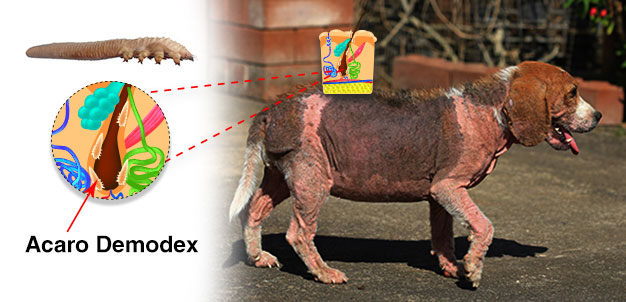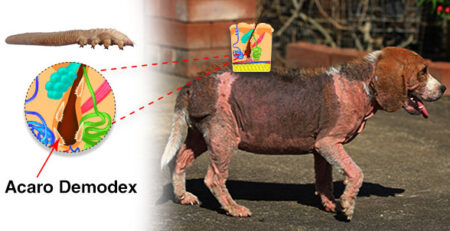Table of Contents
Dog demodectic mange or red mange: is a dermatitis due to the overgrowth of a particular mite that usually lives on the skin of four-legged animals.
The mites responsible for mange are of the genus
Demodex
and are transferred from the mother’s skin to that of the pup through contact during nursing.
Generally, most dogs live in harmony with these mites, present in small numbers, without ever suffering any consequences from their presence.
If, however, alterations in the natural balance of the skin occur, mites begin to multiply uncontrollably and cause the onset of the disease.
What triggers the replication of demodectic mange mites?
Parasite replication is the consequence of a defect in the subject’s immune capacity and is not contagious to humans or other dogs.
It is a congenital mite-specific immune deficiency that prevents pups from developing an effective response against the parasite population.
The causes of reduced immune defenses also include certain diseases including Ehrlichiosis, Leishmaniasis, Cushing’s Syndrome, and Cardiopulmonary Filariasis or the use of immunosuppressive drugs such as cortisone.
This is the case for dogs with mange in adulthood.
Most affected are purebred dogs but crossbreeds and mestizos are not entirely excluded.
What are the symptoms of demodectic mange?
In a localized form, mange is mostly seen in very young individuals, 3 to 6 months of age, up to 12 months. Most often it is self-limiting and rarely recurs.
The most frequently affected areas (snout, head, and front legs) exhibit:
- alopecic (hairless) areas
- scabs
- erythema
- Reddening of the skin (hence the widespread habit of calling demodectica, Red mange)
However, the localized form of mange can worsen and become generalized
Generalized forms are quite similar to localized but much more severe and extensive, with complications of pyoderma (inflammation of the skin) setting in due to the reduced defense status of the skin.
In generalized forms, there are several districts involved, from 5 to 6 or more areas, with large lesions that may even be scattered over the entire body.
Other manifestations may be:
- intense itching
- pain
- lymph node enlargement
- fever
- anorexia
- Septicemia due to bacterial complications in severe cases
How is demodectic mange diagnosed?
Demodex mites live in the hair follicle and sebaceous glands of all dogs.
So to unearth them, it is necessary to perform a deep scraping and subject the sample to a microscope and highlight their number.
How is demodectic mange treated?
Assessments of the patient’s general health status should be made first, especially in severe cases where symptoms show major complications.
Treatment of both local and generalized mange consists of oral medication or in the form of ointment or shampoo.
The drug to be used and the doses should be indicated by the Veterinarian, but in general, pesticides with acaricidal potential are used for a longer or shorter period.
However, it is indicated to perform diagnostic checks every 2-4 weeks to check the course of the disease.
Treatment should be continued for at least 8 to 12 weeks after the first negative skin scraping.
If no recurrence has occurred for at least 12 months, the dog is considered cured.
Can demodectic mange be prevented?
Since the mite responsible for demodectic mange normally lives on the animal, it is impossible to eradicate it.
There is no way to prevent its presence.
However, it is possible to prevent the disease by always checking that the dog lives in a clean environment, does not stress unnecessarily, eats well, and undergoes regular anti-parasite treatment.
Have your dog regularly examined and do not hesitate to contact us at the onset of suspicious symptoms.
In this regard, we would like to remind you that our Staff Veterinary Doctors are at your disposal and that Clinica La Veterinaria is always open daily h24 including holidays and with Emergency Service from 8 pm to 8 am.
For the joy of seeing them HAPPY











